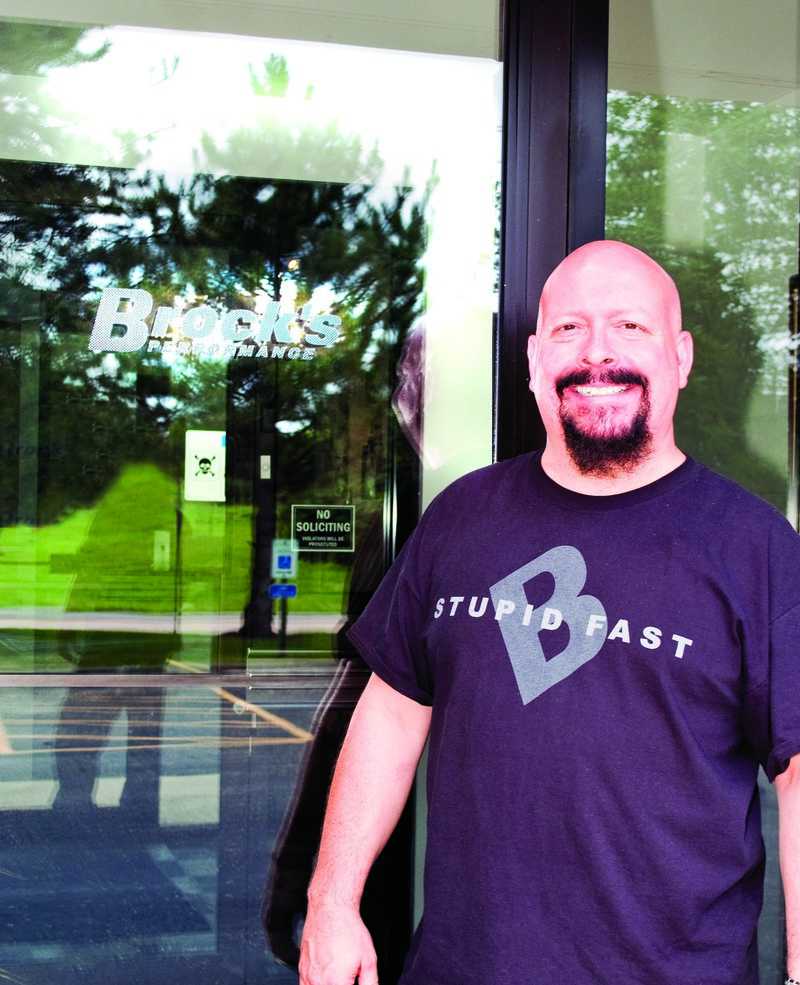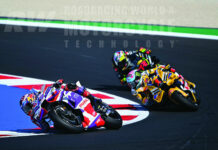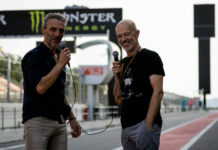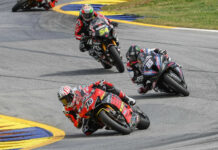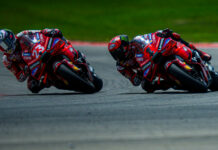**Note: This edition of Shops originally appeared in the October 2013 print edition of Roadracing World & Motorcycle Technology magazine. Don’t miss out on other exclusive content like this found only in Roadracing World – Subscribe today!** Knowing how to go fast and win are key to being successful in racing. But knowing what it takes to turn a racing hobby into a profitable business designing, manufacturing, distributing and selling parts is another thing completely. The two tasks require largely different skill sets, but both take the vision of an innovator and the steely determination of a leader like Brock Davidson of Brock’s Performance. Davidson came from a working-class family living in the suburbs of Dayton, Ohio, and his father owned a motorcycle at one point. Davidson‘s mother bought him a Honda XR75 when he was 12 years old, but his biggest two-wheel influence came from a neighbor who let the pre-teen ride a stretched-out, big-bore, 10-second Kawasaki Z1 drag bike around the block. “Man, I hit the gas on that thing and took off,” said Davidson. “I got that feeling of acceleration and I was hooked. The next thing you know I had wheelie bars on my XR75.” When Davidson was 16, his father bought him a car to drive to school and work, and the youngster immediately sold it to buy a Kawasaki H2 750cc two-stroke Triple. Later, using money earned from a part-time job, Davidson was able to buy a 1982 Suzuki Katana GS1000, one of the fastest bikes at the time. “I put a big block on it, 33mm smoothbore carbs, cams,” said Davidson. “I took it to the (drag strip) and it went fast. Then a friend of mine asked if I would build an engine for his 1983 GS. He paid me for it. Then it started steamrolling.” After high school, Davidson attended tech school, went to work as a mechanical engineer, got married and had kids—-but he continued building engines for money in his spare time, and that financed his drag racing habit. “I sort of kept the bike stuff and the engineering stuff separate,” said Davidson. “I had people say, ‘Why don’t you start your own business?’ I would say, ‘Why ruin a perfectly good hobby?’” But that only lasted for so long, because Davidson’s talent at his job was solving problems and racing is all about solving problems. Eventually, Davidson started making parts to fix problems he encountered while racing his own bike, and he sold copies to Schnitz Racing, which marketed and retailed them. “I had a full-time, 40-hours-per-week job, plus I was racing and building engines for people on the side, so I didn’t really have the time to market products,” said Davidson. “I would solve my problem, design these parts, have them mass-produced here in Dayton and send a box to Schnitz. They would send me a check, package them up and sell the parts under their name.” Davidson said one of the reasons it was easier to start manufacturing parts than it might have been was the fact that so many quality machine shops were located in the Dayton, Ohio area. “Dayton is a great town, a machining town,” said Davidson. “They used to call it ‘Little Detroit.’ A lot of automotive. We have a military base, so a lot of military stuff. So there’s a lot of resources in Dayton.” One of Davidson’s first parts was an internal shift shaft that had the ability to bend under certain loads (like when a drag racer with an automatic transmission set-up backed off and unintentionally engaged two gears at once) and then snap back straight. Another part was a showerhead distribution block to be used with nitrous-oxide injection for a consistent supply to all cylinders. “So I designed this (distribution block), and one of the nitrous companies, NX, Nitrous Express, they called me up and wanted to buy them from me,” said Davidson. “So these guys are buying hundreds and hundreds of these things because ‘The Fast and the Furious’ movie had just come out, and NX was selling these to car guys. And we also sold them to bike guys through Schnitz (Racing).” But balancing work, racing and his growing parts business was starting to become too much to handle, according to Davidson. “I got to the point where I was going to work to rest,” said Davidson, who decided to make a huge leap of faith and give up his full-time job and steady paycheck to go racing full-time. “I had never done anything like that before. I had always been employed, so that was a very big step for me. I remember two weeks after I did it I didn’t have a paycheck. It was a scary time, but it was exciting, too. I’m a racer. I don’t fail. There wasn’t going to be any failing under any circumstances. It was going to be OK, but it was definitely scary.” One of the things that made it OK was the fact that Davidson had landed a deal in 1999 to run American Suzuki’s official team in the AMA Prostar Supersport and Superbike classes. “I had a rough deal,” said Davidson. “I had to go outrun Rob Muzzy and Ricky Gadsen. That was my task.” And the first season was the roughest, said Davidson, who was literally blown off his GSX-R750 Superbike while trying to find the best way to use nitrous-oxide and fuel-injection. But with a little help from the Yoshimura Suzuki road racing team and plenty of trial and error, Davidson got things running right, and in 2000 he won the AMA Prostar Superbike Championship. But the biggest point of Davidson’s drag racing career and a pivotal point for his business was actually when he became the first rider to record a quarter-mile drag racing pass in the seven-second range on a modified streetbike. “My bike was a streetbike,” said Davidson. “In March of that year I put 400 miles on it at Bike Week, and then in May I ran 7.97 seconds at 180 mph and broke into the sevens before anybody else. That bike was awesome. “It was a 1997 Suzuki Bandit 1200. We had a (rule-mandated) max 68-inch wheelbase. When I started measuring the Bandit it looked like I could lower the bike, rake the front end and by the time it was done end up with a swingarm that was an inch longer than if I ran a GSX-R. And that one inch was huge with a set wheelbase. That would put the weight an inch further forward. Keeping wheelies down was the key to our competition, and that one inch I believe was one of the determining factors to me getting into the sevens before the rest of the guys. It was a big deal in our sport. Everyone was trying to do it. It was covered everywhere. It was on TV. I was interviewed by Dave Despain. After I did that my phone just blew up with people calling me.” At the same time, Suzuki had just introduced the Hayabusa, which was instantly popular with drag racers. Davidson immediately started addressing the bike’s weak points—including its clutch—and designed a high-performance racing exhaust system with former road racer Lang Hindle. “All the pipes on the market, when you lowered the bike for drag racing the pipe took away the ground clearance. All the pipes were too low,” said Davidson. “I thought we could do better. Lang said, ‘Come on. Let’s do it.’ I went to his place, and we designed a pipe that made more horsepower than the other guys but also had additional ground clearance for drag racing. Ground clearance is huge in drag racing. For general rule we figure for every inch you lower your bike you can pick up a 10th of a second, which a 10th of a second is huge. So we designed a pipe, came back, tested the pipe at the track, tested it against other pipes, and it really worked well.” Between exposure for putting his modified streetbike into the sevens and his emerging line of parts to support the new Hayabusa, Davidson’s small home-based parts business quickly grew to where he had to tell Suzuki he was stepping away from drag racing full-time to focus on his business. “They (Suzuki) were great about it. They understood,” said Davidson, who years later came back to win several AMA Prostar and AMA Dragbike Supersport National Championships on a Suzuki. “Things started rolling from there. I got to the point where I couldn’t do it out of my house anymore. I ended up incorporating because there was just too many people. I went from by myself to one helper, then another helper and then the next thing I knew I had four or five people working for me.” Davidson moved the business out of his home and into a 1200-square-foot commercial building, where Brock’s Performance operated for five years. “We got to the point where we had product stacked all the way to the ceiling. We had boxes stacked around the sprinkler system heads. It was tight,” said Davidson, who relocated to his current 10,000-square-foot building in 2008. “It’s been a great move. Depending on the time of year we average about nine people on full-time staff here. In the springtime we’ll have as many as 13 or 14 (workers). “I always have contract people that we work with: Engineers, designers, people that I have trusted over the years to help me out with things. I used to do a lot of the design myself, and many of our ideas still come directly from my head but not necessarily straight to the computer now because there just doesn’t seem to be time for that anymore. Now I do the R&D and new product development. And I’ve been doing quite a bit in marketing lately, but I’ve been trying to take some of that away. I actually hired a young man to help me out with that, because it got to be time-consuming. I’m trying to get back into more of the R&D and product and development.” As with many motorcycle-related businesses, Brock’s Performance was hit hard during the recession and sales dropped 50-60%, Davidson said. And compounding that, AMA Dragbike (the successor of AMA Prostar) went bankrupt and shut down operations in the middle of the 2010 season, leaving companies like Brock’s Performance one less way to market their products. “Well, while everyone else decided to say, ‘The economy’s terrible. Woe is me! Woe is me!’ We said, ‘We need to do something here,’” said Davidson. “We decided to go and embrace social media. We had just started to develop parts and do a little bit of drag racing with a BMW. We showed up at our first drag race on an S1000RR, and the racing organization went bankrupt. So we decided to go to a regional event. We did a video of our rider breaking into the eights on this S1000RR. I had my graphics staff put it to some popular music, and all of a sudden we have 80,000 views on YouTube within 30 days. We asked BMW if that was OK, and they said, ‘Heck, yeah! Can you do more of that?’ Sure. Exposure is exposure. Plus we were developing product for the BMW.” The BMW S1000RR that Davidson refers to is his personal bike, which with just bolt-on parts produces 200 horsepower on race fuel and runs the quarter-mile in 8.44 seconds at 164 mph. That performance publicized via social media got the attention of a new market. Many of the products Brock’s Performance developed for and highlighted on the bike—-including BST carbon-fiber wheels and Brock’s new CT series full-titanium racing exhaust system—-also became popular for track-day riders, land-speed record chasers and road racers, including multi-time CCS Regional and National Champion Nate Kern. “The next thing you know, we found a whole new customer base,” said Davidson. “Sales picked up, and at the end of that year not only had we filled in that gap that we had lost, we ended up for the year. It wasn’t anything huge, but considering how far down we went, we were covered.” To handle the expanded product line (Brock’s Performance has 3500 active part numbers) and improve service for his thousands of retail customers and dealers now and in the future, Davidson also invested in a new warehouse management e-commerce platform that includes real-time information for staff, dealers and customers. For customers, the system tells them if the part they want is in stock and how long it will take to ship it to them—-three days or less via UPS Ground for 70% of the U.S. population, according to Jeff Grieco, Brock’s Performance VP of Operations. Dealers get the same inventory information plus pricing, and Brock’s can drop-ship the item directly to the customer, saving the dealer from stocking the item or reshipping it. And for Brock’s Performance, the system allows 99.9% accuracy in order fulfillment, which pretty much means 99.9% customer satisfaction. The key to the system is barcoding. Everything that comes in or goes out the doors is barcoded. This system not only helps manage inventory levels, it tells order pickers where to go get the parts and even routes them through the warehouse while picking up multiple-part orders so they don’t have to backtrack. The system also alerts staff when low levels of inventory are reached so more parts can be made or ordered from vendors. “This thing is more powerful than we will probably ever need,” said Davidson, “but the important part is no customer disappointment.” And customer service is and has always been one of the core priorities for Brock’s Performance. A good example of this is the fact that the company doesn’t just sell exhaust systems. It sells exhaust systems with free fuel-injection maps specific to each application, whether it’s for a production bike burning pump gas during track days or a racebike launching hard while burning potent race fuel. “I’ve got a guy I pay who does nothing but mapping (on the company’s Dynojet Model 250i dynamometer), and he sends you the map that you need for your application,” said Davidson. “It’s expensive, it’s time-consuming, it’s a pain in the ass, but it’s what our customers demand. And it works out well for us.” With the economy slowly growing, Davidson said his efforts are focused on first maintaining that high level of customer satisfaction, followed by promoting the company through social media exposure and by supporting racers and developing new products. Those products include a new exhaust canister that is very quiet at low rpm but makes increased horsepower at higher engine speeds thanks to its internal design. And although he never sits still for very long, Davidson is enjoying the ride. “It’s really unbelievable that I get to wake up and do this,” he said. “It’s just the greatest thing ever. I’m like a little kid when I get to talk about it. That I get to do this and get paid for it and to watch where it’s gone over the years, is just amazing.” RW
Shops: Brock’s Performance
Shops: Brock’s Performance
© 2013, Roadracing World Publishing, Inc.
